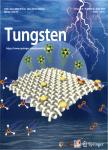Atomic-scale mechanisms of void strengthening in tungsten
Atomic-scale mechanisms of void strengthening in tungsten作者机构:Materials Science and Technology DivisionOak Ridge National LaboratoryOak RidgeTN 37831USA
出 版 物:《Tungsten》 (钨科技(英文))
年 卷 期:2021年第3卷第1期
页 面:65-71页
核心收录:
学科分类:08[工学] 080502[工学-材料学] 0805[工学-材料科学与工程(可授工学、理学学位)]
基 金:financially supported by the Office of Fusion Energy Sciences U.S.Department of Energy under contract DE-AC05-00OR22725 with UT-Battelle LLC
主 题:Tungsten Neutron irradiation Voids Radiation-induced hardening Dislocations Dispersed barrier hardening
摘 要:Neutron and heavy-ion irradiation of tungsten produces nanometer-size vacancy voids,gas-filled bubbles and dislocation *** defect features can a ect mechanical properties and the impact can be quite significant because of their high *** the basic mechanisms of mechanical properties degradation is necessary for predicting radiation e *** can be made using discrete dislocation dynamics or/and finite element approaches which,however,need local interaction mechanisms as *** knowledge can be provided only by atomic-scale *** paper reports the results of an extensive atomic-scale modeling study of the interactions between moving edge dislocations and voids in *** main focus is on the e ects of the void size and ambient *** resolved shear stress was calculated for voids up to 9 nm in *** results are compared with the theoretical approach and with those obtained earlier for voids in body centered cubic(bcc)*** important role of the void surface has been revealed.



